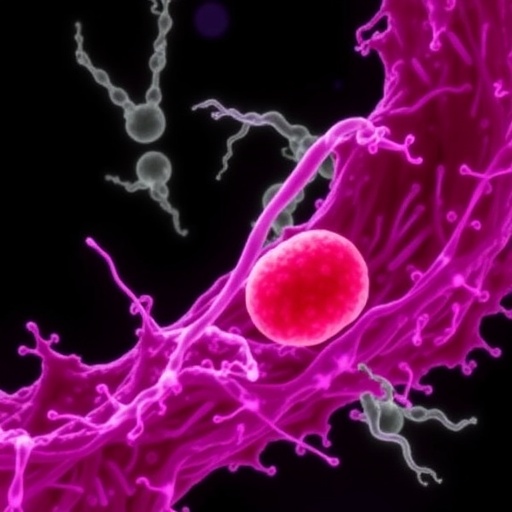
In a groundbreaking study, researchers Wu, Shao, Hu, and their colleagues have unveiled a remarkable advancement in the field of antifungal agents: the discovery of indole-carbohydrazide hybrids as a new class of broad-spectrum fungicidal compounds. Their work, published in the journal “Molecular Diversity,” reveals not only the potential efficacy of these compounds against various fungal pathogens but also outlines an innovative mechanism of action that targets cellular membranes. This discovery poses significant implications for the treatment of fungal infections, which remain a critical threat to global health.
Fungal infections are a rising concern in modern medicine, compounded by the increasing rates of antifungal resistance. Traditional antifungal agents often fall short against resistant strains, necessitating the search for new therapeutic options. Wu and his team have made strides in this area by synthesizing a series of indole-carbohydrazide hybrids characterized by their potent antifungal properties. Through meticulous experimentation, they have demonstrated that these novel compounds possess broad-spectrum activity against a variety of fungal pathogens, including those resilient to existing treatments.
The synthesis process employed by the researchers is noteworthy for its innovative approach and efficiency. By strategically combining indole and carbohydrazide moieties, the team crafted a series of hybrids that exhibit enhanced biological activity. Their synthetic method not only minimizes waste but also enhances the feasibility of producing these compounds on a larger scale, which is critical for eventual therapeutic use in clinical settings.
One of the standout features of the indole-carbohydrazide hybrids is their mechanism of action. Unlike many conventional antifungal agents that target specific enzymatic pathways, these compounds act primarily by disrupting the integrity of fungal cell membranes. This membrane-targeting mechanism is both novel and potent, allowing the indole-carbohydrazide hybrids to compromise the cellular architecture of various fungi, leading to cell lysis and death. This distinctive action highlights a promising avenue in antifungal chemistry that could potentially outmaneuver resistance mechanisms typically seen in pathogenic fungi.
The breadth of activity demonstrated by these compounds is another aspect that merits attention. The study showcased the hybrids’ effectiveness against clinically relevant pathogens, which include both dermatophytes responsible for skin infections and systemic fungi that pose severe risks to immunocompromised individuals. The ability of these compounds to target a wide array of fungi suggests that they could serve as versatile agents in the antifungal arsenal, offering new hope for patients suffering from difficult-to-treat infections.
Furthermore, the research team conducted extensive in vitro and in vivo studies to evaluate the efficacy and safety profiles of these novel compounds. Through rigorous experimentation, they provided compelling evidence that the indole-carbohydrazide hybrids maintain potent antifungal activity while exhibiting low levels of cytotoxicity towards mammalian cells. This balance is crucial for any potential antifungal therapy, as high toxicity can lead to adverse effects and limit the therapeutic window for treatment.
In correlating the structure of these hybrids with their antifungal activity, the researchers embarked on a detailed structure-activity relationship (SAR) analysis. By systematically modifying different components of the indole-carbohydrazide structure, they identified key substitutions that significantly enhanced both antifungal potency and selectivity. Such insights pave the way for further optimization of these compounds, potentially leading to the development of even more effective antifungal agents.
One of the more intriguing aspects of this research is its implications for the future of antifungal drug development. The successful incorporation of the indole and carbohydrazide moieties into a single compound format could inspire similar strategies in the design of other hybrid molecules. Such hybridization techniques may serve to circumvent the limitations of existing antifungal therapies and provide a framework for the development of new agents capable of overcoming the growing threat of drug resistance.
In light of these findings, the question arises: how will the scientific community and pharmaceutical industry respond to the potential of the indole-carbohydrazide hybrids? With ongoing challenges in treating fungal infections, the urgency for innovative solutions continues to escalate. It will be vital for researchers to collaborate with industry leaders to expedite the translation of these promising discoveries from the laboratory bench to clinical application.
Moreover, the implications of this study extend beyond the realm of individual antifungal agents. The membrane-targeting mechanism identified in the indole-carbohydrazide hybrids could inspire similar approaches in the design of other types of antimicrobial agents, potentially benefiting the broader field of infectious diseases. As researchers continue to unravel the complexities of microbial resistance, such innovative strategies may be key to staying one step ahead in the fight against resistant pathogens.
Overall, the findings of Wu and colleagues represent a significant milestone in antifungal research. The discovery of indole-carbohydrazide hybrids not only addresses a critical need for new antifungal therapies but also sheds light on a novel mechanism of action that could redefine how we approach the treatment of fungal infections. The promise of these compounds serves as a reminder of the importance of continuous research and innovation in the face of emerging health challenges.
In conclusion, the potential of indole-carbohydrazide hybrids as broad-spectrum fungicides heralds a new era in antifungal therapy. As the scientific community delves deeper into the intricacies of these compounds and their mechanisms, we may witness a paradigm shift in how we combat fungal infections globally. The journey from discovery to clinical implementation may be long, but the insights gained from this respective research endeavor will undoubtedly inspire future investigations and therapeutic strategies against one of the most insidious threats to human health.
Subject of Research: Antifungal agents, indole-carbohydrazide hybrids
Article Title: Discovery of indole-carbohydrazide hybrids as novel broad-spectrum fungicidal lead compound through membrane-targeting mechanism
Article References:
Wu, Y., Shao, LH., Hu, XQ. et al. Discovery of indole-carbohydrazide hybrids as novel broad-spectrum fungicidal lead compound though membrane-targeting mechanism.
Mol Divers (2025). https://doi.org/10.1007/s11030-025-11326-z
Image Credits: AI Generated
DOI: 10.1007/s11030-025-11326-z
Keywords: antifungal agents, indole-carbohydrazide, broad-spectrum, membrane-targeting mechanism, drug resistance
Tags: antifungal agentsantifungal resistance solutionsbroad-spectrum fungicidescellular membrane targetingfungal pathogen treatmentglobal health implicationsindole-carbohydrazide hybridsinnovative antifungal mechanismsmodern medicine challengesnew therapeutic optionspotent antifungal propertiessynthesis of hybrid compounds




